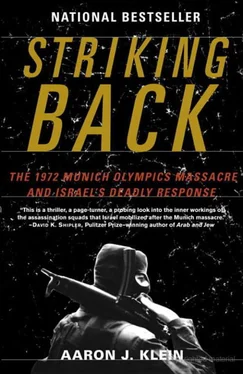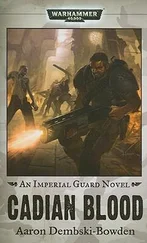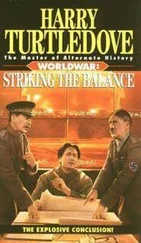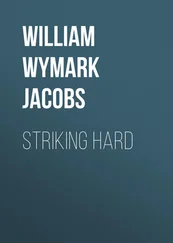The Palestinians tell a different story. Both Abu-Daoud and Tawfiq Tirawi, a senior deputy of Abu-Iyad’s and current head of the General Intelligence Apparatus in the West Bank, acknowledge a long litany of attacks orchestrated by Salameh in Europe, but categorically deny his involvement in the Munich attack. When speaking with Tirawi in his Ramallah office, he made clear to me that his intention is not to belittle Salameh’s lifework, but to set the record straight. Salameh, though, was a braggart, unafraid of embellishing the truth. His bravado reached the Tzomet division and they duly reported that his hands were red with the blood of the murdered at Munich. The Israeli media crowned him “The Red Prince.”
Salameh was responsible for four major terror attacks in Europe and one in Asia, according to Palestinian sources. The first, with the aid of Muhammad Boudia, on March 15, 1971, entailed the explosion of a 16,000-ton oil tank in Rotterdam. The second came on December 15, 1971, and involved a lone terrorist who waited in ambush for Ziad Al-Rifa’i, the Jordanian ambassador in London. Rifa’i was lightly wounded in his hand. The third attack was perpetrated in Cologne, Germany. On February 6, 1972, five young Palestinians with Jordanian passports—supposedly Mossad agents—were shot and killed. Half a year later, on August 4, 1972, he planned an attack along with Boudia that resulted in the blowing up of the oil storage tanks in Trieste, burning 200,000 gallons of oil used primarily by Germany. Then too Black September took responsibility for the attack. The fifth attack planned by Salameh was the unsuccessful takeover of the Israeli embassy in Bangkok in late December 1972. There, the terrorists agreed to be flown to Egypt empty-handed. Salameh was furious with the outcome, taking the lack of determination on the terrorists’ part as a personal insult. There were some in Arafat’s inner circle who took care to remind him of the failure in Bangkok now and again.
In conversations I had with senior ex-Caesarea officers they looked at their desire to kill Salameh in terms of closure—we want to “close the circle,” they said. To set the record straight after the disaster in Lillehammer. The passing of time did not cool that desire: it intensified it. From 1972 onward many terrible attacks were carried out by Palestinian terrorists, claiming dozens of innocent lives, and yet no one hurried to draw Xs on the faces of those responsible. Few were added to the Mossad hit list. Salameh, despite a period of silence, never stopped being a top priority. “At that time, were there senior Palestinian activists more deserving of the opportunity to meet their creator than Ali Hassan Salameh?” I asked a senior Mossad officer. The reply: “Undoubtedly, yes.” Despite the steep price invested, in terms of money, technological resources, and manpower, Caesarea’s combatants remained devoted—the chase bordered on obsession.
In the second half of 1978 the noose began to tighten. A careful analysis of the abundant intelligence pouring in isolated a few weak points that could, with proper planning, be made into a Capture Point. Salameh was good about going to visit his mother and sisters. The Mossad recognized that in order to reach the building they shared he had to pass along the north–south route of Verdun Street. That was the Capture Point. In 1978, the Mossad decided to send an undercover Caesarea combatant to Beirut. She, like Sylvia Raphael, worked for the Mossad part-time, only when asked.
Tel Aviv decided that the combatant, who had been trained well for her position in Caesarea, would take up residence in a flat in Beirut that overlooked Verdun Street and collect information about Ali Hassan Salameh. The combatant, exposed many years ago as Erika Chambers, came to Beirut in November 1978, carrying a British passport issued on May 30, 1975, number 25948. She made sure that her neighbors took note of her harmless eccentricities, painting wildly and feeding the neighborhood cats. Her cover: she was a worker at a Palestinian children’s aid organization.
Chambers rented an apartment on the eighth floor of a luxury building on January 10, 1979. From her apartment in the Anis Assaf building she could see narrow Beka Street, into which Salameh turned on his afternoon journeys from his wife’s flat. Chambers rented the place for three months, paying 3,500 Lebanese pounds up front. The Lebanese investigative report states that two foreign men, one Canadian and one British, entered the country with fake papers and passports. They were Caesarea combatants.
At 1525 hours, on January 22, 1979, Ali Hassan Salameh left his pregnant wife and got into the tan Chevrolet that waited for him with its motor running. Two bodyguards rode with him in the Chevy and two more climbed into the Land Rover following them. Salameh was on the way to his mother’s house for the birthday party of his niece, Nidal’s daughter, who turned three that day. A video camera had been purchased for the occasion.
The convoy slowly turned right onto the narrow Beka Street, where a rented Volkswagen waited on the left-hand side of the road, packed with eleven pounds of hexagene, a plastic explosive equal to seventy pounds of dynamite. One of the combatants stood a hundred yards away and watched the convoy approach. He flipped the switch on the detonator as the Chevrolet rolled past. The explosion rocked the whole block. An eyewitness described seeing a ball of fire and then hearing a deafening explosion. Cars lit up in flames and several bodies were strewn on the street, burned by the flames. One man stumbled out of the car and fell to the ground. People recognized him even in his current state—Abu-Hassan, Ali Hassan Salameh, they said. He was taken to the hospital, where he was pronounced dead.
Salameh’s funeral was well attended. One memorable scene from that day: Hassan, the thirteen-year-old son of the shahid, sitting in Arafat’s lap, an AK-47 in hand, a kaffiyeh similar to the one Arafat wore across his shoulders, and a military beret on his head. It seemed clear that he represented the third generation of armed struggle.
At twenty-nine, sixteen years after the funeral, Hassan returned to Palestine as a businessman and took up residence in Ramallah. Hassan Ali Salameh, educated in some of the best private schools in England, had a different take on life than that of his father and grandfather. “My father wanted me to be brought up away from his kind of life. I have a genuine desire for peace and I have a different mentality from the fighters of the past,” he said.
TEL AVIV, MOSSAD HEADQUARTERS
OCTOBER 1986
In autumn 1986 the members of the Target-Tracking Committee were called to the “Seminary,” the Mossad’s instructional facility. Located on a slight hill overlooking the sea, it was a place to which the military men, in flannel shirts and jeans, were always happy to come. Aside from the benefit of shedding their uniforms, they knew lunch would be world-class. The Mossad was famous for it. Many heads of state were received in the Seminary. Golda went there to relax after cancer treatments.
Each member of the five-person forum understood that a vital piece of raw intelligence regarding a major terrorist had come through the pipes. In an upstairs room, with the sea twinkling outside the window, they would be asked to analyze the intelligence and determine whether it was significant enough to put a person on, or off, the target list. Today’s news was different. The Mossad Facha division head waited for everyone to take their place around the hardwood conference table before he let the news spill out. “They’re all dead,” he said of the terrorists responsible for the Munich Massacre. “None of them are breathing anymore.”
Читать дальше












